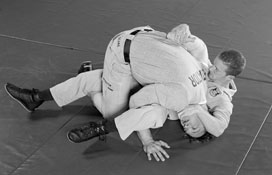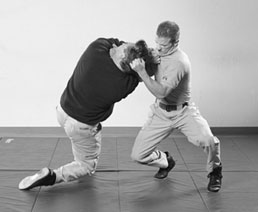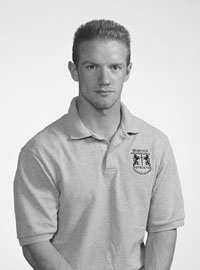Published
May 1999
By
Herb Borkland
About the author:
Herb is a free-lance writer and martial artist based in Sandy Spring, Maryland.
Reprinted with permission from Black Belt Magazine and Herb Borkland.

The Special Combat Reactionary System (SCARS) is the first official hand-to-weapon fighting system of the U.S. Navy SEAL teams. SCARS is now declassified and out on videotape. It's also being taught by its creator, Jerry Peterson, to a limited number of civilians on a once-in-a-blue-moon basis.
I am proud to be the first journalist ever invited to undergo SCARS training. Going in, I was more than a little curious about a contemporary combat system that uses no blocks whatsoever and consists of nothing but finishing shots - a system that Navy admirals consider to be unbeatable. Just how tough is SCARS training? Our camp had already lost two guys by lunchtime on the first day. One man broke his wrist. He wasn't used to being thrown, especially by someone who wasn't used to throwing. But the second camper quit outright, despite having paid $5,000 to be there. He just couldn't stomach the brutality.
Phoenix, Arizona was still hot and dry last October at our 40-hour SpecOps/ SEAL Platoon Work-Up Camp. Those in attendance were paying bargain rates to study with millionaire shadow-ops guru Jerry Peterson, a.k.a. "The Deadliest Man Alive." Five thousand dollars plus traveling expenses is a bargain? Yes since Peterson earns up to $1,700 an hour.
Thirty-two men from 20 to 60 converged on Phoenix's SCARS Institute of Combat Sciences. They were not SEAL wannabes in camo pants who talked only about their knives. On the contrary, our group of campers consisted of average Joe's: skinny and large, short and tall, white, yellow, black and brown. Among us were a retired Fortune 500 CEO, a distinguished veteran of the Army Delta Force and the Marines, a plain-spoken young dude from Kansas who claimed to "just own some trucks," a polite Indian businessman who confessed to feeling so out of character that he had to tell his office staff white lies about the subject of this Phoenix "seminar," and a sawed-off monosyllabic Arizona SWAT-team leader with sniper's eyes and memorably hard fists.
Aside from an enviable amount of disposable income, all the campers shared one crucial distinction: Each had been exposed to one of the most successful video self-defense courses in history, Jerry Peterson's SCARS tapes. Those 1993 training tapes came out of that covert "nowhere" in which spies always seem to work. They were advertised in only four limited circulation national magazines. Yet Peterson's course went on to gross $1 million in only its first nine months on the market. Business analysts were dazzled.
There's one excellent reason why the original SCARS tapes made so much money worldwide: They were breathtakingly pricey, the single most expensive set of self-defense videos ever put out. Yet they undoubtedly rank among the least expensive to produce. They were made in one take, virtually overnight, for next to nothing using shortcuts which video pros promised would never succeed.


We campers were bedded down at comfortable motels and picked up at 6:45 each morning for a short mini-van drive to the Institute. Seen by early sunlight, the 20,000 square-foot SCARS Institute's contemporary Western architecture recalls an Old West adobe monastery. A Shaolin Temple for cowboys?
The Institute is a spec-ops boutique which normally deals with armed forces, military and paramilitary professionals, the security staff of international corporations and even South American billionaires and their bodyguards.
Off the Institute's private parking lot is the outside entrance to a two-story arrangement of office spaces, a kitchenette and two bathrooms. The low-key decor is functionally anonymous; only the presence of guns and lions suggests that this firm does anything more strenuous than tweak software.
However, along the far wall leans a row of dummy assault rifles and faux 9mm semiautomatic pistols. For realistic training, these industrial-plastic reproductions exactly duplicate the original models' weight and heft.
A banner spread across another wall displays the SCARS escutcheon: a naked sword between lions, haloed by the legend "SCARS Institute of Combat Sciences - Proven in Combat."
Part of what this motto means is that SCARS president and Vietnam veteran Jerry Peterson has killed the enemy. More than a few were taken out with his bare hands, including, most terribly, four at once "because there wasn't room to shoot them."

Finally, a yellow and red water barrel sits on a shelf strewn with plastic cups and extra-large bottles of over-the-counter painkillers. This snapshot image, captioned "Thirsty and Hurting," would sum up the basic SCARS training experience.
For the next four days, we spent 11 hours of our nonstop 14-hour days on those mats. Three hours daily were given over to one-hour catered cafeteria-style breakfasts, lunches and dinners. We ate together at long communal tables set up in the reception area. And, unlike Elvis, we never left the building.
The space beyond the mat room is a two-story 10,000 square-foot "environment room" where mission specific installations are built to suit the training requirements of whatever contract is currently being serviced at the Institute. When a tactical law enforcement unit needed an indoor rappelling tower complete with water hazard and white sand beach, SCARS put them in.
We never got into the environment room. However, its very existence powerfully underscored one humbling fact: Occasionally training a handful of civilian amateurs is not really what this Institute is all about. If you are used to studying only with teachers whose qualifications center around having won a lot of plastic trophies, you can feel the difference in authority immediately.
The SCARS Institute feels serious. This place is not a martial arts school. It does not teach sports or sportsmanship. Most of the people who train here are paid professionals of covert violence who are about to go in harm's way.
The basic staff consists of Jerry Peterson, and his right hand man and son Blake Peterson , plus a rotating crew of hand-picked "operators" who are proficient in various specialties and brought in as needed.
During breakfast on the first morning of the camp, without any fanfare Jerry Peterson appeared among us. I examined him carefully and told myself, "This guy makes a seven-figure living by walking into roomfuls of bloody minded security experts and proving to them, in front of their superiors, that they don't know squat about their own trade."It's something that only a genius could get away with, much less make money at.
In person, California-born Peterson is a tanned, trim man of medium height who projects easy-going candor. A youthful 50-something, he looks like a morphing of three cinematic icons of no sweat masculinity: Kris Kristofferson, Jon Voight and Nick Nolte, depending on which angle of his face you see.
Peterson is a decorated Vietnam-era Army veteran of Charlie Company of the famed 173rd Airborne. The 173rd took the brunt of the fighting during the 1968 Tet offensive. Peterson survived what military historians concede was among the harshest combat of that ugly war. His unit's job was to go into hot zones and pull out other troops in trouble.
In recent years, Peterson has done extensive contract work for various units under the U.S. Special Operations Command, which controls the Army, Navy and Air Force special-operations forces. He has been employed by the Department of Energy's critical materials transport people, various Drug Enforcement Agency counter-narcotics units, and the Department of Treasury's U.S. Secret Service members. This is documented by the numerous thank-you plaques that hang on the Institute's walls.
Other government and federal units have also been trained by Peterson, but SCARS will neither confirm nor deny anything. And that makes sense, because before anyone can train such groups he has to sign a pile of documents saying that he'll never say he trained them. And that's just Peterson's Washington resume. Currently a small infamous Eastern European nation wants him to revamp its entire military. Meanwhile, back in Hollywood a SCARS TV show has been scripted and cast: it awaits only the green light. The Today Show keeps calling, too.
On day one, Blake introduced himself and passed around spiral bound copies of Manual #1, Hand-to-Hand Combat for United States Operations Forces Army/Navy/Air Force. Every single page of course material is slashed diagonally with "Restricted Copy-Property of SCARS Institute."
The meat of this text consists of 25 combat lessons. Each one is a sequence of four or five techniques, usually including a throw, initiated off an opponent's punch or kick. These sequences contain no defensive moves whatsoever. Instead, all checks to attacking arms or legs are delivered as intercepting counterstrikes aimed at specific nerves.
Whenever Peterson taught us, he wore a wireless microphone. A staff video cameraman followed him around, taping every move. On this first morning, Peterson gathered us in the mat room. He began by outlining the value of what SCARS calls the "offensive mind-set."
"This is why defensive fighting systems cannot win against SCARS, Peterson told us. Diagrams on the blackboard indicated that direct offensive action is always quicker through the nervous system than the stop-and-catch-up reactions of a defender. "SCARS is literally faster than any other kind of fighting," he said.

Yes. It is a core concept that Peterson calls "autokinematics." Briefly put, he has spent 20-plus years researching the effects of shocking force on every vulnerable nerve, bone and organ in the human body. Not just the various injuries which can result, but precisely how the entire body will react at the instant it is struck.
What is ground-breaking comes from grasping the combat implications of one simple physiological fact: When it comes to absorbing punishment, every human body reacts in exactly the same way.
So from its first blow, SCARS attacks the autonomic nervous system, which controls such instinctive behavior as pulling fingers out of fires, lifting bare feet off sharp sea shells and everything else we do before we can stop ourselves from doing it.
By knowing in advance which reactions the enemy will be unable to suppress - and therefore which targets his recoiling body will next expose to attack - a SCARS fighter can seize control of his opponent and work the man like a pain puppet. SCARS puts the enemy through a nonstop series of traumas which will increasingly incapacitate - or ultimately kill him. What is truly unprecedented is how complete, detailed and scientifically absolute Peterson's grisly research is. Since it is proprietary information, it's difficult to cite examples of SCARS. However, to give the smallest sample, suppose you poke somebody in the eye. SCARS can tell you not only how his head and torso will instantly and involuntarily react, but also exactly where he will move both hands and one of his two legs. SCARS extends this sort of merciless insight over every single inch of the human body. This leads to, among other things, a whole genre of combat techniques which are new to most martial artists.
Chalk talks were few and far between the camp. Instead, we were almost always paired, to practice combat lessons at half-speed. SCARS is so fast hat you have to practice it slowly. In conventional two-man self-defense sets, he opponent attacks, gets blocked and then stands around straight-faced while is partner follows up with multiple high speed blows. SCARS partners, in contrast, must learn to precisely mimic the autokinematic reaction caused by striking any given body part. We don't just stand there: we flinch, fold, lurch or fly, depending on how a real-world opponent would react.

The focus of training is not so much on committing sequences of moves to memory; it is about learning to fluently, ceaselessly attack body targets, and in the learning process, you are expected to get a little banged up - for your own good.
Working through the 25 basic combat lessons took three days of relentless practice. We were not permitted to buddy up for long, so every set of techniques was tried over and over again on every one of the 30-odd campers. Since most lessons also contain a throw, everybody was hitting the mat endlessly.
By the second day, we were doing it by the numbers, and the pace got even brisker. Over the long 40-hour haul, not being able to handle getting repeatedly thrown seemed to account for most of the problems campers experienced. Another difficulty was guys accidentally eating a technique. One camper took a heart shot and proceeded to demonstrate the precise autokinematic reaction we had been taught to expect. The incandescent pain only abated never ended for this camper. It kept him awake at night. Nonetheless, he completed the course.
Peterson's training style is reasonably grueling. One camper thought he broke a rib, and Peterson said, "Hold your arms over your head."
Wincing, the camper did so. Peterson slapped his flanks hard with both hands. The camper went white-faced with pain. "No," Peterson continued affably, "you're OK. If any ribs were broken, you'd be on the floor by now." To change the pace, our long training days were broken up by supplementary drills. One involved putting on a "flak jacket." Then we proceeded to drive our partners backward the length of the room using full-force fist, elbow and palm strikes to the torso. At the far wall, partners would then exchange the jacket, and the "beatee" became the "beator."
Our SWAT-team leader hit so hard that Peterson finally asked him to pull his punches. And that nice Indian fellow gave me a sternum shot that I could feel for days.
Later, after trying all our upper-body weapons, we went on to further explore various ways of kicking each other to and fro. When asked why we performed this exercise, Peterson spoke of "Learning the autokinematics." But I think a large part of it also has to do with his strong conviction that a fighting course in which no one gets banged up is phony. "You have to learn how to take shots," he remarked later.
The training peaked in intensity on Saturday night. After another long sweaty day of grinding it out, we were by-God told to stop acting like a bunch of sissies and start really trying to hit our training partners. By now, if somebody wasn't deft enough to stop an attack - well, too bad.
We got into doing line drills in which you keep personally creaming the entire class. Every student freestyled with everyone else over and over. By now, a few guys had opted out and were standing around the walls just watching. But the rest of us were going through a roomful of fighters single-handedly and never once repeating a sequence of moves. We had achieved impressive combat efficiency.
Overall, the curriculum turned out to be more varied than I had expected. During the 40 hours, we practiced hand-to-weapon attacks using padded clubs and knives. Then we went on to study disarms involving rifles and semi-automatic pistols. The same basic SCARS moves and principles always carried over seamlessly to all those ancillary exercises.
At another point, Peterson discussed Brazilian jujitsu and demonstrated how SCARS treats grapplers. Some grapplers among us put him in some of those "inescapable death holds," and he always broke free within two or three seconds. As always, too, each camper was immediately made capable of doing exactly what Peterson had done. Bland as this may sound, it is what trainers are paid to do but rarely achieve so well.
After being challenged by one participant, Peterson duplicated a stunt famous from his magazine ads. Thirty of us could not pin him against a cinder block wall. A minute later - having seen him do it once - each of us was making Peterson's escape work for us.
Peterson is able to do all those "miraculous" things because he applies universal physical principles to specific situations; he does not just remember moves shown to him by somebody else. The significance of that cannot be overestimated. It means that SCARS is alive and still evolving.
The camp's emotional climax came after our last lunch together. We all sat around the long tables, applauding each other for having made it through, Peterson and his staff dealt out handshakes and certificates that cited "extreme training conditions including extensive physical hardship." We were named "qualified SCARS training partners." Instead of a handshake, our Indian partner insisted on hugging Peterson to great laughter and applause.
The rest of Sunday was largely given over to a seminar on how to deal with carjackers. Huge doors were opened, the mats peeled back and a sweet-looking red pickup was driven inside.
We were told that the teachings we were about to receive had already saved real-world lives among SCARS adepts. But tomorrow was another hard Monday, and various guys had various planes to catch. One by one, the campers began peeling out of formation and heading home to nurse their bruises.
And me? In 40 hours, everything I thought I knew about unarmed combat got turned on its head. I found out that the Navy SEAL fighting system is simple and groundbreakingly complete, easy to learn and yet unanswerable.
I have seen the future of self-defense, and it is SCARS.
Social & Professional